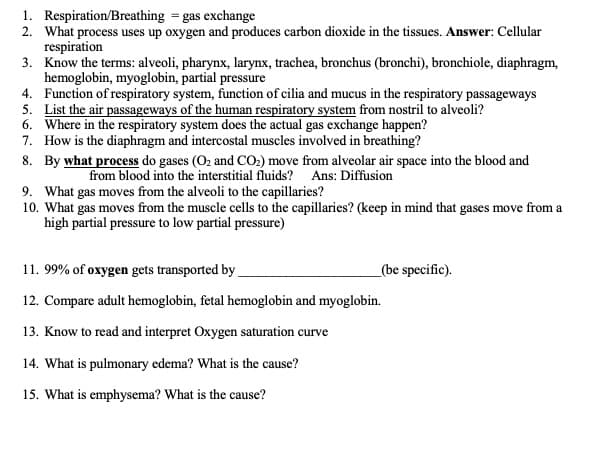Biomedical Instrumentation Systems
1st Edition
ISBN:9781133478294
Author:Chatterjee
Publisher:Chatterjee
Chapter11: Instrumentation In Respiration
Section: Chapter Questions
Problem 1P
Related questions
Question

Transcribed Image Text:1. Respiration/Breathing = gas exchange
2. What process uses up oxygen and produces carbon dioxide in the tissues. Answer: Cellular
respiration
3. Know the terms: alveoli, pharynx, larynx, trachea, bronchus (bronchi), bronchiole, diaphragm,
hemoglobin, myoglobin, partial pressure
4. Function of respiratory system, function of cilia and mucus in the respiratory passageways
5. List the air passageways of the human respiratory system from nostril to alveoli?
6. Where in the respiratory system does the actual gas exchange happen?
7. How is the diaphragm and intercostal muscles involved in breathing?
8. By what process do gases (O2 and CO.) move from alveolar air space into the blood and
from blood into the interstitial fluids? Ans: Diffusion
9. What gas moves from the alveoli to the capillaries?
10. What gas moves from the muscle cells to the capillaries? (keep in mind that gases move from a
high partial pressure to low partial pressure)
11. 99% of oxygen gets transported by
_(be specific).
12. Compare adult hemoglobin, fetal hemoglobin and myoglobin.
13. Know to read and interpret Oxygen saturation curve
14. What is pulmonary edema? What is the cause?
15. What is emphysema? What is the cause?
Expert Solution
This question has been solved!
Explore an expertly crafted, step-by-step solution for a thorough understanding of key concepts.
Step by step
Solved in 2 steps

Knowledge Booster
Learn more about
Need a deep-dive on the concept behind this application? Look no further. Learn more about this topic, biology and related others by exploring similar questions and additional content below.Recommended textbooks for you


Biology: The Dynamic Science (MindTap Course List)
Biology
ISBN:
9781305389892
Author:
Peter J. Russell, Paul E. Hertz, Beverly McMillan
Publisher:
Cengage Learning

Biology 2e
Biology
ISBN:
9781947172517
Author:
Matthew Douglas, Jung Choi, Mary Ann Clark
Publisher:
OpenStax


Biology: The Dynamic Science (MindTap Course List)
Biology
ISBN:
9781305389892
Author:
Peter J. Russell, Paul E. Hertz, Beverly McMillan
Publisher:
Cengage Learning

Biology 2e
Biology
ISBN:
9781947172517
Author:
Matthew Douglas, Jung Choi, Mary Ann Clark
Publisher:
OpenStax

Concepts of Biology
Biology
ISBN:
9781938168116
Author:
Samantha Fowler, Rebecca Roush, James Wise
Publisher:
OpenStax College

Cardiopulmonary Anatomy & Physiology
Biology
ISBN:
9781337794909
Author:
Des Jardins, Terry.
Publisher:
Cengage Learning,
